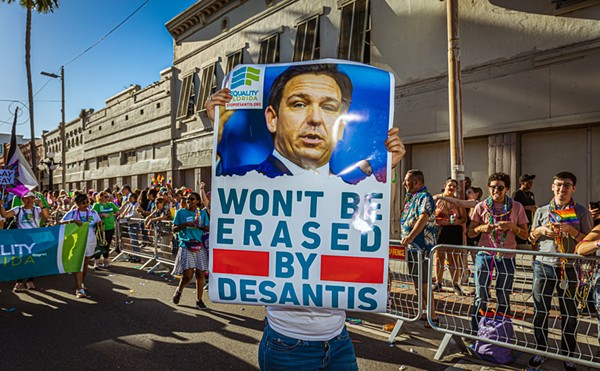All I wanna do is make art and get paid," says Bradley Arthur, standing by his imposing metal sculpture near the entrance of the Hillsborough County Sheriff's Operation Center in Ybor City.
It's a shiny sweater day in December, the kind that tends to lift the spirits, but Arthur's mood is dark. His energies have not been directed much toward artistic creation of late. Instead, he's locked in a dispute with the county's Public Art Committee. The 6-ton sculpture and a companion piece at the Citrus Park sheriff depot have begun to rust. Sheriff's personnel have complained. Commissioner Ronda Storms has called them eyesores.
The committee wants Arthur to fix them, to make them shiny like when they were installed in October and December of 2002.
In a letter early last month, assistant county attorney Susan Fischer told Arthur to submit a plan to buff the pieces up by Jan. 15 or the county would find an outside contractor to "cure the defect" and "seek to recover these costs from you." In other words, the county is preparing to sue the man they commissioned to create two of the most impressive works in its public art program.
Arthur contends that the rust was inevitable. He was contractually required to use recycled metal from the county's Gun Buy-Back program. Gunmetal rusts — it's that simple. Even though the artist applied clear coating to the melted-down weapons, he says he was well aware they would rust, although he admits the corrosion began more quickly than anticipated. "It's such a wonderful work and no one is saying anything except about the rust," Arthur says. "It's painful."
Further, Arthur suggests that the rust is part of the pieces' status as living art, a common theme in works subjected to the elements. He's a gregarious sort who loves discussing meaning and subtext and symbolism. He's given to making lofty statements that can sound pretentious to people less aesthetically minded. At the Ybor City sculpture, he kneels to rub off a reddish smudge. "It's like the piece is crying," he says wistfully.
The county no longer wants to hear this sort of thing. Legalese has taken over.
Arthur has a heightened sense of principle that can blind him to opportunities for compromise. He says he cashed out a life insurance policy and remortgaged his Land-O-Lakes home to stay afloat during this three-year project and subsequent ordeal. Yet thus far he is not looking for a way out. Instead he continues to defy county officials, communicating without a lawyer. Arthur contends the county owes him up to $50,000 on top of his original $120,000 fee because he received the gunmetal eight months late, which cost him other work opportunities.
"They count on artists not being able to go the distance when they turn it into a legal battle," Arthur says of bureaucracies.
He's not the sort of artist to back down. Arthur is already embroiled in a lawsuit with Temple Beth-El in St. Petersburg. In the late '80s, he installed a large outdoor piece call "The Wave" at an art show there. He says temple officials asked him to leave it on loan, which he did for a dozen years until they tried to move it. In Arthur's view, the move broke the sculpture and temple personnel simply discarded it. Temple Beth-El lawyer Henry Stein counters that the sculpture "was [already] broken. It was an eyesore and dangerous to anyone walking near or into the temple." The case will likely go to trial in the spring.
While Arthur possesses considerable charm, he can piss folks off. Several members of the Public Art Committee have called him extremely difficult to work with. "As much as I'm fond of him, I was shocked at his insulting behavior toward the committee," says former committee member Wallace Wilson, director of the School of Art and Art History at USF. "I would sit there and be amazed at how he was biting the hand that was feeding [him]. When it came down to the rust issue, he'd burned his good will."
Arthur's arch foe is Jan Stein, the county's coordinator of public art. If one interview is any indication, she too can be difficult. During a meeting at the Weekly Planet offices, she came equipped with a stuffed box of documents and correspondence and, instead of engaging in conversation, proceeded to read several of them aloud. She repeatedly interrupted questions and even proceeded to "object" to certain turns of phrase, as if in a legal proceeding.
It seems clear that personality conflicts are at play in this standoff. It seems equally evident that county officials have decided to play hardball. You might even say they're looking to punish this pain-in-the-ass artist.
Ultimately a judge or jury may have to decide: Is the rust on the sculptures a matter of inevitable change or is it a defect? Were county officials responsible for seeing that Arthur received the gunmetal on time? And if so, do they bear some burden with regard to his lost wages?
It could get even weirder. Under a little-known federal statute called the Visual Arts Right Act, the county may not have the right to de-rust, even if it's willing to cover the cost. Arthur could argue that the corrosion is part of his artistic intent and, therefore, removing the rust would be tantamount to defacing the art.
When asked repeatedly whether he would take such a course, Arthur said he simply did not know. "First let the public art committee show some respect for artists, let them pay me the money they owe me and allow the public to learn about the sculptures and the material used," he says. "And then discuss what the options are."
If things get diceywhen art and commerce meet, they can be that much more precarious when art converges with government. Beefs between artists and bureaucracies are commonplace. The key to avoiding such problems, public art experts say, is clear and specific communication between the purchaser and the creator, especially at the outset. "There's a very high likelihood of misunderstanding because the world of the artist is totally different than the world of politicians," says Bruce Allen, chair of the Department of Arts and Visual Culture at Centenary College of Louisiana. "Bureaucrats understand what everyone else wants and put that into action. Artists figure what's inside themselves and how to put it out there. They don't care what people think — in a good way. It's like 'Here I am, here's what I've done, accept it or reject it.' The government agencies that purchase the work are accustomed to looking at objects and surface. Artists are looking at structure and meaning."
The communication between Arthur and the county started out fine. Hillsborough County issued a Call to Artists and the committee was so impressed with Arthur's ambitious plan he easily won out over another finalist.
By any measure, the sculptures, titled "Components of Public Safety, I & II," are remarkable. The Ybor piece features a steel circle — 7 feet in diameter, 2 feet wide — encasing a stainless steel, five-point star, representing the sheriff's badge. Most of the area surrounding the star is filled with the gunmetal, which was melted down in a Jacksonville foundry along with other scrap steel and then crafted into sections of rebar and 5-inch by 5-inch metal billets.
The first signs of trouble came when the county issued Arthur the contract, which stated that it would own the copyright. He was "outraged," because it's standard in deals of this nature for the artist to retain copyright.
Fischer, the assistant county attorney, maintains the contract was a boilerplate agreement and negotiable. Stein said that, over the course of a decade, only one other artist had challenged the provision and procured a copyright. Which raises questions: Had the county been habitually heisting artists' copyrights? Even though their actions were perfectly legal, were they treating the artists ethically? Arthur thought not, and fought it.
After a few months of wrangling, with the help of pro bono work by Ft. Lauderdale lawyer Keith Poliakoff, Arthur won the copyright to his project. (The county has since changed its standard contract, with the copyright going to the artist.)
Arthur started construction with energy and zeal, corresponding enthusiastically with Stein and the committee.
Did they talk about the potential of rust? The committee didn't ask. He didn't tell. Arthur says he knew the pieces would rust and applied clear coating in hopes of slowing it down. The county says it was the artist's responsibility to inform them of the potential corrosion, and further, he withheld the information for fear that his proposal might not be accepted. They see his clear coating as a de facto warranty against rust.
The county's legal stance is at odds with other art lawyers and experts. "It's very analogous to a construction case where something has to be built according to specs," says Miami arts and entertainment lawyer Steven Eisenberg. "He built it according to their specs. They specified the use of gunmetal. It behooved the county to know it was going to rust. I don't see how they can hold him responsible for the rust. As for the coating, just because he took an extra step does not amount to a guarantee against the rust."
Poliakoff does not represent Arthur in this dispute, but said, "The county's argument is like the U.S. suing France because the Statue of Liberty turned green. This is gunmetal. It will rust. If it turned to gold would they have a problem?"
George Beasley, a sculpture professor at Georgia State University in Atlanta, has a 40-foot high metal sculpture in that city's downtown. "It's generally understood that metals change," he says. "They're going to develop a patina. One would assume that committee would be well versed in that regard. It's silly to assume that art is somehow bulletproof compared to other things [a county] buys and deals with. If a roof needs replacing, they put a new roof on."
Beasley also faults bad communication and planning. "Almost all public art should have a built-in maintenance schedule," he says. "And often times contracts have setback amounts of money invested toward maintenance."
"Components of Public Safety" has no specific maintenance plan, although the contract calls for Arthur to warranty the work for three years. (The College Art Association of America's Ethics and Guidelines on public art say the artist's responsibility should last no longer than a year.)
In October, the county paid an Orlando area art conservator $900 to interpret the rust issue. John Maseman of the South Florida Conservation Center played it down the middle. His report said that the clear coat Arthur applied might be accelerating the corrosion by "allowing water, salts and oxygen to reach the metal from the edges and holding it there under the intact areas of the layer." But he further concluded that the sculpture "appears to be structurally sound," and "given the nature of this sculpture's construction and shape it would be very difficult if not impossible to apply any surface coating system that would totally prevent corrosion."
Maseman recommended stripping the clear coat and reducing the corrosion chemically or mechanically, then applying two coats of fine wax and polishing it. He declined to offer a cost estimate.
When asked outright if the rust was a defect, Maseman said, "I gave them the condition report. I don't know if I would consider it defective. Metal is supposed to corrode at some point."
If Arthur seems on solid footing with regard to the rust issue, his position seems less strong regarding his claims for additional compensation. His position is this: Doing sculptures of such magnitude is a full-time job. The lengthy delay in receiving the gunmetal cost him new commissions and caused him to incur other expenses.At the project outset, Arthur began communicating with the sheriff's department about the availability of the guns. He dealt with the foundry about the process of recycling the material. When he was denied access to the actual meltdown, he had a deputy videotape it for him.
Why did it take so long to get the gunmetal? The process of cataloguing the turned-in guns lasted longer than expected. By the time Arthur received his billets and rebar last June, his deadline to finish the pieces was already a few months past.
Could one county agency, the public art committee, have intervened with another, the Sheriff, to help Arthur get his gunmetal more quickly? It seems reasonable. But Stein and Fischer say they were not involved in that aspect. Besides, Arthur's contract rendered him completely responsible for procuring material, obtaining permits, buying insurance, even installation.
If he was anxious over the schedule, concerned about losing other work, he apparently didn't let on. It wasn't until late in the game that he started making claims for additional money.
The committee's first inclination was to consider providing him some financial relief. Awarding him an extra $50,000, though, was out of the question. The committee asked the artist to establish his lost work and cost overruns but found his documentation unsatisfactory. "At one point he broke down what he would charge on an hourly basis," Fischer says. "He didn't sign a contract to work on an hourly basis."
Stein was further peeved when Arthur had his pieces put up without a mandatory pre-installation meeting. "At the very least it's rude," she says. "And it's very likely a contractual breach."
Arthur admits that his renegade installations were motivated in part by resentment. But he also worried that the relationship had soured so badly that Stein might prevent him from installing the sculptures altogether.
Despite being left out of the loop, the county decided to leave the pieces where they stand. And where they rust.
Arthur understands that Sheriff's personnel and passersby might not like a large rusting metal star in front of these facilities. "But I don't make signs, I make art." Then he turns more conciliatory. The corrosion carries a more profound message, he explains. "The piece is alive," he says. "You can't stop rust. You can't stop crime. The star itself, made out of stainless steel, will never rust."He would like to see a sign near the sculptures that would explain the ever-evolving nature of the work and its inherent statement.
He beckons a deputy who's walking by. He asks Patty Morris, who works in community relations, what she feels about the corrosion. She was more bothered by the fact that a tree was uprooted to make room for the sculpture, but felt better when she found out it had been replanted.
Arthur offers a few interpretations of the rust. The corrosion of society juxtaposed with the glistening strength of the star and circle. How the rusting gunmetal, representing crime, is controlled by the gleaming star.
Morris pauses to give the sculpture an appraising look. "No, the rust really doesn't bother me," she says.
Arthur smiles and puts a little kick in his step as he walks into the shiny afternoon.
Contact Senior Writer Eric Snider at [email protected], or 813-248-8888, ext. 114.















